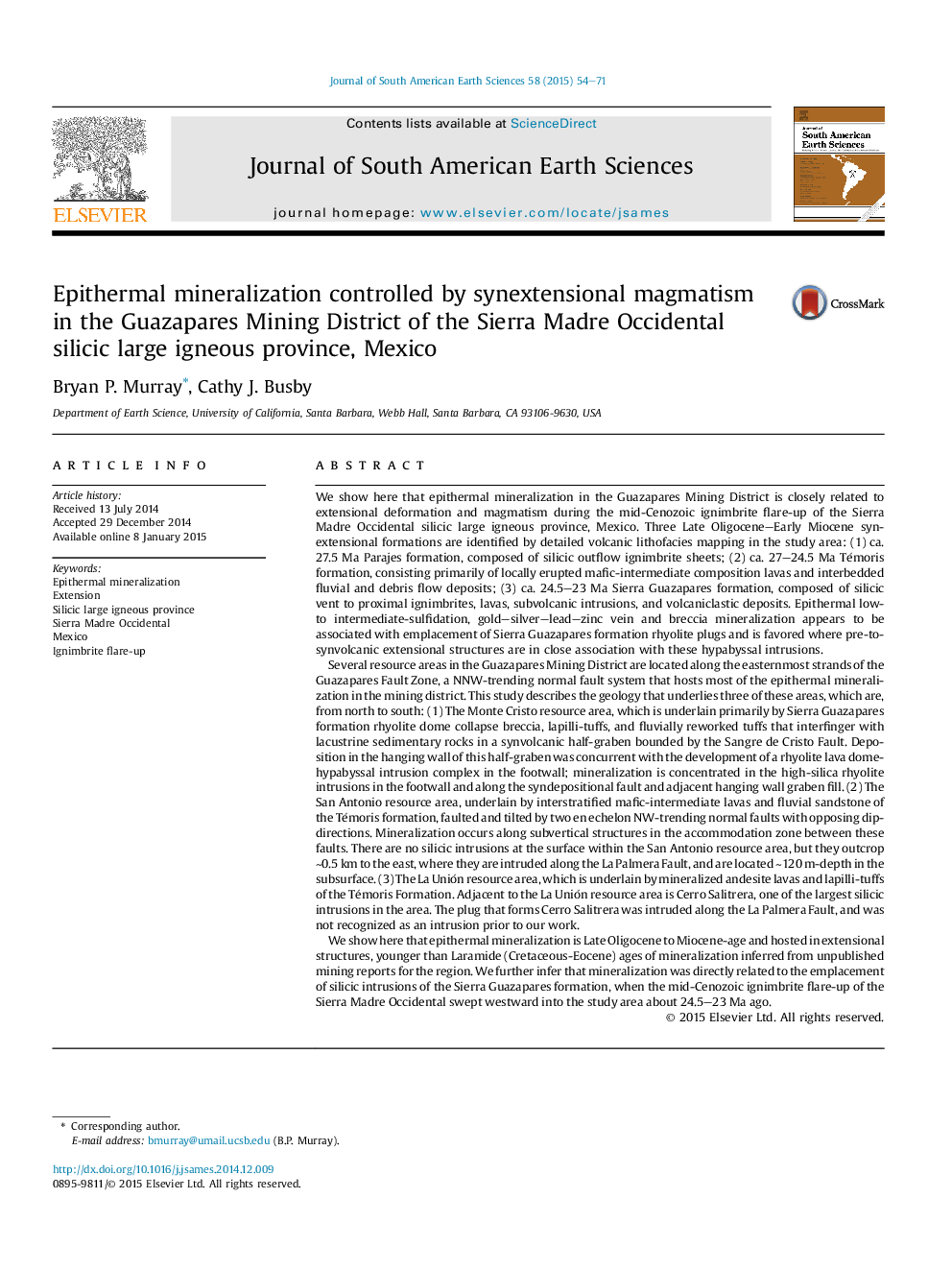| کد مقاله | کد نشریه | سال انتشار | مقاله انگلیسی | نسخه تمام متن |
|---|---|---|---|---|
| 4682259 | 1635151 | 2015 | 18 صفحه PDF | دانلود رایگان |
• Mineralization is related to mid-Cenozoic ignimbrite flare-up magmatism.
• Relative timing of extensional structures and magmatism influences mineralization.
• Epithermal mineralization is hosted by normal faults of the Guazapares Fault Zone.
• Normal faults site silicic intrusions and intrusion-related epithermal deposits.
• Intensity of mineralization increases in proximity to silicic intrusions.
We show here that epithermal mineralization in the Guazapares Mining District is closely related to extensional deformation and magmatism during the mid-Cenozoic ignimbrite flare-up of the Sierra Madre Occidental silicic large igneous province, Mexico. Three Late Oligocene–Early Miocene synextensional formations are identified by detailed volcanic lithofacies mapping in the study area: (1) ca. 27.5 Ma Parajes formation, composed of silicic outflow ignimbrite sheets; (2) ca. 27–24.5 Ma Témoris formation, consisting primarily of locally erupted mafic-intermediate composition lavas and interbedded fluvial and debris flow deposits; (3) ca. 24.5–23 Ma Sierra Guazapares formation, composed of silicic vent to proximal ignimbrites, lavas, subvolcanic intrusions, and volcaniclastic deposits. Epithermal low-to intermediate-sulfidation, gold–silver–lead–zinc vein and breccia mineralization appears to be associated with emplacement of Sierra Guazapares formation rhyolite plugs and is favored where pre-to-synvolcanic extensional structures are in close association with these hypabyssal intrusions.Several resource areas in the Guazapares Mining District are located along the easternmost strands of the Guazapares Fault Zone, a NNW-trending normal fault system that hosts most of the epithermal mineralization in the mining district. This study describes the geology that underlies three of these areas, which are, from north to south: (1) The Monte Cristo resource area, which is underlain primarily by Sierra Guazapares formation rhyolite dome collapse breccia, lapilli-tuffs, and fluvially reworked tuffs that interfinger with lacustrine sedimentary rocks in a synvolcanic half-graben bounded by the Sangre de Cristo Fault. Deposition in the hanging wall of this half-graben was concurrent with the development of a rhyolite lava dome-hypabyssal intrusion complex in the footwall; mineralization is concentrated in the high-silica rhyolite intrusions in the footwall and along the syndepositional fault and adjacent hanging wall graben fill. (2) The San Antonio resource area, underlain by interstratified mafic-intermediate lavas and fluvial sandstone of the Témoris formation, faulted and tilted by two en echelon NW-trending normal faults with opposing dip-directions. Mineralization occurs along subvertical structures in the accommodation zone between these faults. There are no silicic intrusions at the surface within the San Antonio resource area, but they outcrop ∼0.5 km to the east, where they are intruded along the La Palmera Fault, and are located ∼120 m-depth in the subsurface. (3) The La Unión resource area, which is underlain by mineralized andesite lavas and lapilli-tuffs of the Témoris Formation. Adjacent to the La Unión resource area is Cerro Salitrera, one of the largest silicic intrusions in the area. The plug that forms Cerro Salitrera was intruded along the La Palmera Fault, and was not recognized as an intrusion prior to our work.We show here that epithermal mineralization is Late Oligocene to Miocene-age and hosted in extensional structures, younger than Laramide (Cretaceous-Eocene) ages of mineralization inferred from unpublished mining reports for the region. We further infer that mineralization was directly related to the emplacement of silicic intrusions of the Sierra Guazapares formation, when the mid-Cenozoic ignimbrite flare-up of the Sierra Madre Occidental swept westward into the study area about 24.5–23 Ma ago.
Journal: Journal of South American Earth Sciences - Volume 58, March 2015, Pages 54–71
